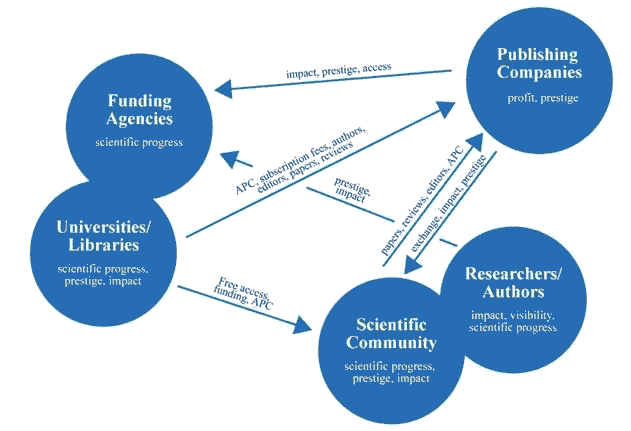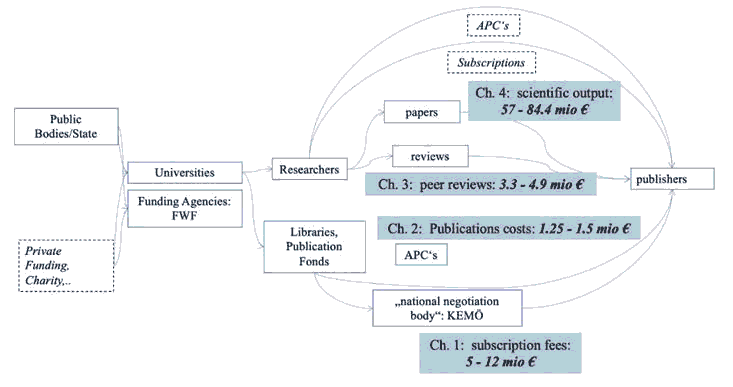Short communication: 2021 Vol: 24 Issue: 6S
Monopolies in science publishing: A black hole for public spending?
Stephan Pühringer, Johannes Kepler University
Johanna Rath, Johannes Kepler University
Teresa Griesebner, Johannes Kepler University
Keywords:
Monopolies, Science, Public Spending
One Sentence Summary:
This paper estimates financial flows in academic publishing and provides reform options for science policy.
Citation Information:
Pühringer, S., Rath, J., & Griesebner, T. (2021). Monopolies in science publishing: A black hole for public spending?. Journal of Management Information and Decision Sciences, 24(S6), 1-5.
Abstract
This paper provides a comprehensive account of the direct and indirect channels through which public expenditure benefits big academic publishing companies. Based on a meta-analysis of studies providing estimates of financial flows related to academic publishing and an accompanying survey, we estimate the annual financial flows of public expenditures to academic publishers in the field of social sciences in Austria. We find that about a fourth of annual basic public funding for academic research directly or indirectly benefits a small number of publishing companies. Based on our empirical findings we offer three main reform options for a more democratic and egalitarian form of academic publishing.
Introduction
After the past decades witnessed the emergence of a variety of open-access (OA) models, OA, and, more generally, the aim to provide free access to scientific knowledge, have gained traction and became prominent topics in academic debates across all disciplines (Piwowar, 2018; Else, 2018; Noorden, 2013; Laakso, 2011). This strengthening of OA is undoubtedly related to a variety of factors, including big science funders starting to mandate OA for its grantees as well as new platforms for self-archiving (ResearchGate or Academic.edu) or illegal hosting (Sci-Hub & LibGen), which challenge the traditional business model of academic publishers. However, recently the big academic publishers also increased their efforts to push OA publishing, potentially indicating a shift in their dominant business model (Storbeck, 2018).
Yet, the field of scientific publishing continues to be a very lucrative market for a few dominant companies. More specific, particularly the “big five” (ACS, Elsevier, Springer, Taylor&Francis, Wiley-Blackwell) control about three fourths of the market and have profit margins of up to 40% (Stoy, 2019; Lawson, 2016; Larivière, 2015). In this regard, several studies criticized the black box of costs of academic publishing, i.e. high subscription fees and article processing charges (APC), intransparent “Big-Deals” between academic publishers and distinct national consortia of universities, libraries and national science funders. Although financial stress and concerns on unfair treatment by publishers have on some occasions led to cancellations of subscriptions in large European and U.S. universities (Laakso, 2011; Gaind, 2019), a few top publishing companies still hold a quasi-monopoly position in this market.
While most critical literature on academic publishing is focused on subscription fees and APCs, i.e. the “revenue side” of academic publishing companies, there is hardly any literature on their respective “cost side”, including inter alia the provision of their “product” by authors and reviewers. More specifically, rather surprisingly even critics hardly point to the fact, that academic publishers to a large extent benefit from the strong pressure to “publish or perish” and the academic practice of peer reviewing (see (Else, 2018; Smith, 2018) for notable exceptions). Against this backdrop, our study provides a comprehensive account of the direct and indirect channels through which public expenditure benefits big academic publishing companies. Furthermore, we also estimate the annual financial flows of public expenditures to academic publishers in the field of social sciences in Austria. This way, we aim to open up the debate about the public value and costs of scholarly knowledge and ask whether and under what circumstances public subsidies for economically successful publishing companies can be justified. Eventually, we provide three main suggestions for a more democratic and egalitarian form of academic publishing.
The Field of Academic Publishing: Four Channels of Support for Academic Publishers
In recent decades there is a trend to present the academic field more and more as a competitive market, mediating the scarce resource of scientific prestige. In this process, academic publishers have benefited from the economization of science, i.e. a strong stratification logic based on journal impact factors, citations and academic rankings (for a recent critical account see the DORA initiative). From a birds-eye view the field of academic publishing is composed of five main actors with partly countervailing goals, claims and perspectives: (i) authors, (ii) academic publishing companies, (iii) funding agencies (iv) universities and libraries and (v) the scientific community. Figure 1 provides an overview of the mutual relations of the actors in the field.
In all, the combination of the incentive structures of the current academic system and the intrinsic motivation of individual researchers and academic institutions, offers a very lucrative business model for publishing companies. Apart from several tolls and fees, they receive papers (their “product”) and reviews (their “quality control”) for free. Yet, preparing scientific output and peer- reviewing is part of the scholarly duties of researchers and thus their work is financed by their employers, typically universities. In other words, while scientific knowledge and peer-reviewing are perceived as public goods by academic institutions (and hence largely publicly funded), publishing companies transform these public goods into private goods and receive very high profit margins in exchange. In sum, we distinguish four main channels for publishers to obtain public funding:
• Channel 1: subscription fees, mainly paid by university libraries
• Channel 2: APCs and submission fees, paid either by universities or funding agencies, in rare cases also by individual researchers
• Channel 3: the provision of reviews and journal editorship for journals – free of charge
• Channel 4: the provision of research papers – the main input – free of charge
While the relevant monetary flows to as well as the services provided by publicly employed researchers for the market of academic publishing are typically intransparent and often subject to confidential agreements, we employed the schematic four-channels-model for an explorative case study of academic publishers’ access to public funding in the field of social sciences in Austria. The study rests on two pillars: a meta-analysis of 22 studies providing estimations of costs in curred by the public sector in accordance with our channels-model and a survey conducted among a full sample of Austria social scientists to supplement our analysis. While data for channel 1 and 2 can be taken from existing estimates covering the publishing-related expenditures of Science funds and universities in Austria and Europe (Larivière, 2015; Buschmann, 2015), we employ our survey data to estimate the average time spent to produce the “public goods” (see appendix for data and calculations). Summing up the estimated costs incurred by the public sector across all four channels, the Austrian state provides academic publishers in the field of social sciences by a minimum of approximately € 67 Mio and a maximum of approximately € 103 Mio (Puehringer, 2021). This amount represents about a fourth of the annual basic funding Austrian universities receive from the government in the field of the social sciences (Figure 2). Given that the products sold by academic publishers critically rely on the inputs provided ‘in-kind’ by publicly funded researchers this is best interpreted as an in transparent form of public subsidization.
Figure 2: Four-Channels Model Of Access To Public Funding For Academic Publishers. An Estimation For The Social Sciences In Austria, Based On (Lawson, 2016)
Strategies to Reclaim the Public Good Scientific Knowledge
We found that a substantial share of public funding benefits, directly or indirectly, a small number of top publishing companies. While the open access movement initiated an ongoing debate and several positive developments regarding channel 1 and 2 of our model – subscription fees, APCs and submission fees – channels 3 and 4, i.e. the free provision of peer reviews and research papers are largely understudied. Against the background of our empirical results, we conclude that academic publishing is in urgent need of institutional reform and thus suggest three main reform options in the field of science policy (Table 1).
| Table 1 Reform Options To Democratize Academic Publishing |
||
|---|---|---|
| Reform option | Main objective | Main actors |
| Anti-trust policy | ||

